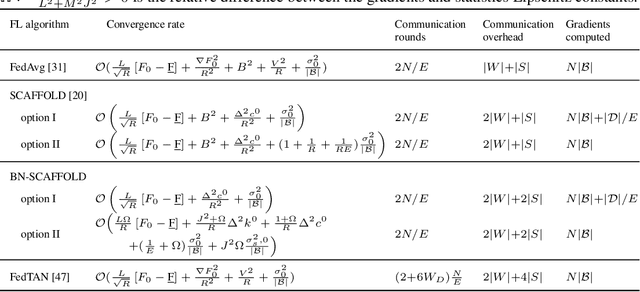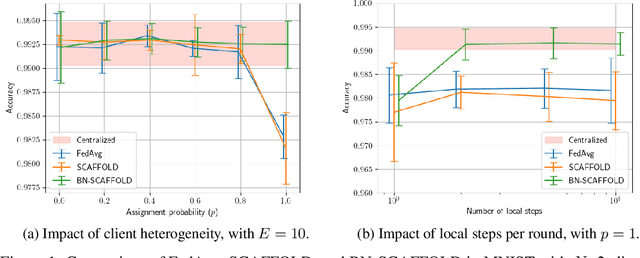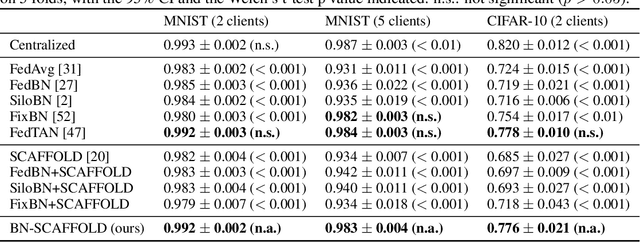Laurence Vancamberg
GE Healthcare
BN-SCAFFOLD: controlling the drift of Batch Normalization statistics in Federated Learning
Oct 04, 2024



Abstract:Federated Learning (FL) is gaining traction as a learning paradigm for training Machine Learning (ML) models in a decentralized way. Batch Normalization (BN) is ubiquitous in Deep Neural Networks (DNN), as it improves convergence and generalization. However, BN has been reported to hinder performance of DNNs in heterogeneous FL. Recently, the FedTAN algorithm has been proposed to mitigate the effect of heterogeneity on BN, by aggregating BN statistics and gradients from all the clients. However, it has a high communication cost, that increases linearly with the depth of the DNN. SCAFFOLD is a variance reduction algorithm, that estimates and corrects the client drift in a communication-efficient manner. Despite its promising results in heterogeneous FL settings, it has been reported to underperform for models with BN. In this work, we seek to revive SCAFFOLD, and more generally variance reduction, as an efficient way of training DNN with BN in heterogeneous FL. We introduce a unified theoretical framework for analyzing the convergence of variance reduction algorithms in the BN-DNN setting, inspired of by the work of Wang et al. 2023, and show that SCAFFOLD is unable to remove the bias introduced by BN. We thus propose the BN-SCAFFOLD algorithm, which extends the client drift correction of SCAFFOLD to BN statistics. We prove convergence using the aforementioned framework and validate the theoretical results with experiments on MNIST and CIFAR-10. BN-SCAFFOLD equals the performance of FedTAN, without its high communication cost, outperforming Federated Averaging (FedAvg), SCAFFOLD, and other FL algorithms designed to mitigate BN heterogeneity.
Deformable registration with intensity correction for CESM monitoring response to Neoadjuvant Chemotherapy
Feb 22, 2023Abstract:This paper proposes a robust longitudinal registration method for Contrast Enhanced Spectral Mammography in monitoring neoadjuvant chemotherapy. Because breast texture intensity changes with the treatment, a non-rigid registration procedure with local intensity compensations is developed. The approach allows registering the low energy images of the exams acquired before and after the chemotherapy. The measured motion is then applied to the corresponding recombined images. The difference of registered images, called residual, makes vanishing the breast texture that did not changed between the two exams. Consequently, this registered residual allows identifying local density and iodine changes, especially in the lesion area. The method is validated with a synthetic NAC case where ground truths are available. Then the procedure is applied to 51 patients with 208 CESM image pairs acquired before and after the chemotherapy treatment. The proposed registration converged in all 208 cases. The intensity-compensated registration approach is evaluated with different mathematical metrics and through the repositioning of clinical landmarks (RMSE: 5.9 mm) and outperforms state-of-the-art registration techniques.
 Add to Chrome
Add to Chrome Add to Firefox
Add to Firefox Add to Edge
Add to Edge